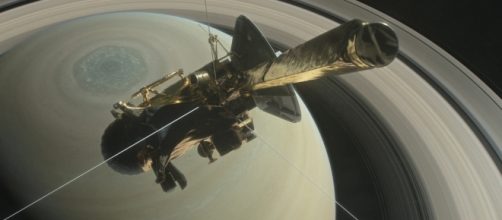The thing about space probe missions by NASA away from Earth is that they take quite a long time – years, even decades – before they give a payoff. There have been probes sent to Mars, the asteroid belt, Jupiter, and then there’s the Cassini-Huygens probe sent towards Saturn.
Launched back in 1997 and reaching its destination in 2004, Cassini has been busy looking at the planet along with its rings and moons. In particular, it got some good looks at both Titan and Enceladus. But now, two decades later, the probe is performing several dives through Saturn’s rings in its final mission phase.
High-speed merry-go-round
For the next 22 Weeks, the Cassini-Huygens probe will perform a daring maneuver that will take it into the gap between the rings of Saturn, estimated to be 1,500 miles wide. To complete a dive through the rings once a week, the probe is set to an impressive top speed of about 120,000 kilometers per hour.
This is some uncharted territory for Cassini so to provide the probe’s body with some protection from particle impact, NASA is directing its dish antenna forward to act as a shield.
When Cassini began its Saturn ring dive this Wednesday, April 26, its course will take it out of contact with NASA back on Earth. However, once the probe makes it past the planet’s rings (and no severe damage is done to the antenna), communications will be restored sometime on Thursday, April 27.
In these high-speed revolutions, Cassini hopes to gather more scientific data that could be used by scientists to figure out how gas planets like Saturn and Jupiter came to be, which may also hold more clues to the origin of the solar system as a whole.
This is it! Through the gap between #Saturn and its rings. Instruments are on, but we're out of contact with Earth. Here we goooooo! pic.twitter.com/3J7aRZS0IH
— CassiniSaturn (@CassiniSaturn) April 26, 2017
Space probe swan song
This daredevil maneuver that Cassini-Huygens has been put through is going to do a number on the probe really. Indeed, it is the planned final phase towards retirement for Cassini after being active for the better part of 20 years in interplanetary space.
For every pass through the Saturn gap that it makes its orbit will begin to decay, and at the end of 22 weeks from when it started, Cassini will plunge into the gassy atmosphere and be destroyed on September 15. This is to ensure that the probe will not wander Saturn’s space after deactivation and damage any of its moons by a collision.
This is another space probe milestone that NASA has reached. Before Cassini’s last hurrah, another probe, Juno, has been busy over at Jupiter last year, transmitting the first close-ups of its north and south poles.

